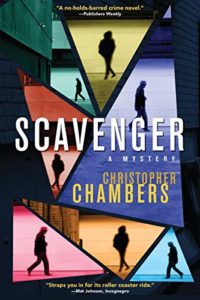A few years ago I heard Irvine Welsh opine that that crime novelist Iceberg Slim “did for the pimp what Jean Genet did for the homosexual and thief and William Burroughs did for the junkie: he articulated the thoughts and feelings of someone who had been there.” I’m not offering that to provide a context for Welsh, who’s magnificently-flawed cops across the Pond would cause even Abel Fererra’s “Bad Lieutenant” to gape. Rather, we need to look at the phrase “someone who had been there,” and tether it to what S.A. Cosby, author of the acclaimed Blacktop Wasteland, told me. “I think we’re at the precipice of a new movement in crime fiction. The sidekicks and set dressing are now the protagonists because the people often most misrepresented in the genre are now writing their own stories at the precise moment, we are experiencing an inflection point.”
Now let’s add to that formula. Among the ragged people, living on the ragged edges, struggling with staying human when humanity is fleeting, crime isn’t the McGuffin, the tour of exotic and dangerous faces and places, the device flipping the pot-boiler to hard-boiled, “gritty.” It’s reality. And thus when writing about the invisible poor and people of color, immigrants in hiding, the rural family enduring the roach motel, the blue-collar drifter chained to an oar in the backwaters—the best resolution of the crime, the heist, the hustle or the horror isn’t the gleaming reveal from the locked room, or punishment of the wrongdoer. The prize is equilibrium—mere balance. This the literature of the hardscrabble.
Some might say that Cosby’s “inflection point” is a victory for “diversity” in American crime fiction. Now let’s applaud then get back to normal. If diversity—to take a biology track—is a function of evolution, then perhaps victory is constant change, rather than “normal.” Indeed, this literature of the hardscrabble has not only bucked the shadow of the “traditional”—it has grown its own family tree. And thus Pauline Hopkins, John Steinbeck, Chester Himes, Horace McCoy, John Fante budded off Iceberg Slim, Donald Goins, Gary Phillips, George Pelecanos, Manuel Ramos, Miguel Piñero, Richard Price, Carmen Amato, Valerie Wilson Wesley and Grace Edwards, Barbara Neely, Paula Woods, who in turn beget Steph Cha, Ivy Pochoda, Attica Locke, Delia Pitts…Richie Narvaez, Ed Aymar, Ava de Leon, Alex Segura and many others who immerse themselves in the invisibles. There’d be no “Dickie Cornish,” the homeless addict in my novel Scavenger, who endures pitiless streets and day labor, without “Easy Rawlins” and “Socrates Fortlow.” There’d be no “Nat McClusky” in Jordan Harper’s She Rides Shotgun or Cosby’s “Bug Montague” without the DNA of Jim Thompson and David Goodis. Finally, Dame Agatha in the drawing room would faint at the domestic malice of Kellye Garrett, Mia Manansala, Abby Vandiver, Valerie Burns, Jen Chow, GiGi Pandian…where the equilibrium women yearn for is…to matter.
The Bad Ole Days…
Our genre celebrates Edgar Alan Poe’s The Murders in the Rue Morgue and The Mystery of Marie Rogêt as its protoplasmic moment of birth. Indeed, from there the model detective, the aristocratic sleuth embodied in “C. Auguste Dupin” similarly sprang. Poe also seeded the police procedural, Holmes-like deduction and Clarice Starling’s intuitiveness fed by behavioral science.
Yet Dupin’s not of the dark and barbarous faces and places providing the “set dressing.” As These Women and Visitation Street author Ivy Pochoda describes both characters and writers of the time, he “dips his toe in it.” He is, thus, a voyeur. Gangs of sailors and drunks provide the “gritty” atmosphere; an orangutan (among the most gentle of primates) becomes a trained killer and exemplar of Dupin’s brain versus exotic ape-ish brawn. Jump ahead a hundred thirty years to Ernest Tidyman, the white man who gave us Shaft, we have similar voyeurism, gathering anthropological notes to provide verisimilitude among the poor, where Goins and Slim actually clocked the time. (But he gets a pass because, well, it’s Shaft. And he penned the screenplay for The French Connection…)
Yet while that pot boiled upstairs, when we travel downstairs, and in the alleys, in the shacks and among the “scurf”— other voices whispered their own stories. A slave named Hannah Craft in the 1850s wrote The Bondswoman’s Narrative about crimes and secrets among her masters. Even more seminal detective works Pauline Hopkins’s Hagar’s Daughter (1902), and John Bruce’s The Black Sleuth (1909), came out in serial form, where laborers and maids solved crimes literally in the shadow of the paradigm set up by Poe with Dupin, and under the noses of overbearing, racist flatfoots. The subtext of these stories is relevant today: we are oppressed, we cannot trust the police to do justice or at least take things back to equilibrium, so we, no matter how lowly, must take care of business ourselves.
George Pelecanos, who body of work on paper and now film, HBO and streaming services is legend, reminded me that Raymond Chandler’s “Phillip Marlowe,” was not a populist, no matter how Bogey played him on film. “Marlow looked down or set himself apart from the lower [working] classes, and Blacks to him were ‘the other.’ [Mickey] Spillane was outright disdainful of non-whites though defenders would say he was ‘of his time.’” Dashiell Hammett, on the other hand, wasn’t a scion of the poor and invisible. He was, however, was a product of left-wing, post-World War I labor politics. “He showed empathy for people who were on the lower rungs on the economic ladder than he was, but his detective protagonists weren’t from that world,” Pelecanos explains. At best, Hammett was the prototype for the traditional track’s more “liberal” or “kinder” portrayals; marginal folk, minorities, were the “set dressing,” props to show what an all-around cool guy Hammett’s gumshoes were. This, of course, connects to the harried, conflicted, good-hearted police procedurals of today…and yet the Tamir Rices, George Floyds, Breonna Taylors remain invisible. The autistic, violin-playing youth Elijah McClain was murdered by the same police department that quietly disarmed a white male mass-shooter in a movie theatre, after all.
For other invisibles, such as poor Latinos, they, too, were a backdrop, seasoning. Coming to “we don’ need no steenkin’ badges” life only when, as crime novelist Manuel Ramos stated in 2001, “…the body count climbs higher and the sleuth unwittingly stumbles into harm’s way, a Mexican here or there injects verisimilitude, sets a tone of truth. But Mexican characters also been included for their exotic or ‘colorful’ natures, a technique that has been criticized as yet another facet of racism.” Gabino Iglesias, author of Coyote Songs, notes how that trend continues to this day, where Latin gangs and cross-border cartels add a level of grittiness, danger. But what about the poor people caught in the middle, or trapped in the rubble of Hurricane Maria on Puerto Rico…or the children in cages?
Indigenous crime writer David Heska Wanbli Weiden, author of Winter Counts, illuminates numerous native authors from the early 20th Century penning detective stories. However, the subject matter did not present the full-bore effects of eradication, colonization, assimilation, poverty, until the 90s—when it hit in a wave of mysteries and thrillers books by indigenous creators.
Then along comes Chester…
In the parlor, the kitchen, the laundry, the nanny’s quarters, the fields, the assembly line or sweat shop floor, more benign neglect until the inspirational and aspirational pulp/noir serials of the 1920s and 1930s. Why? Because these were words any poor child of any race or creed could pull, even second or third-hand and double dog-earred, without the need for today’s rent or food-bill swallowing Wi-Fi or 4G. Stapled to that democratization of literature came what Pelecanos coins as “the populist fiction of the 30s: Steinbeck, John Fante, and newspaper-men-turned-novelists like Horace McCoy and Edward Anderson. They were the first to really feature leading characters from the street. That birthed the pulp crime writers of the 40s and 50s like Jim Thompson and especially David Goodis.” Indeed, Goodis’ Street of No Return features a skid-row protagonist and poor people for whom crime is not an abstraction to be solved, but a condition of life, of fear, that can only be mitigated by appeals to humanity. At the end of the novel, the threat quelled, the protogagnist goes back to the bottle. Equilibrium.
Then along comes Chester Himes. Stints in prison in the 1930s, where he rapped for hours with death row inmates; stretches of personal failure and substance abuse. A taste of the Harlem Renaissance by connection to Langston Hughes, Arna Bontemps, DuBois, Jose Antonio Fernandez de Castro and Zora Neale Hurston; a voyage into expat creativity and limbo, chasing populist writers such as Richard Wright and Ralph Ellison, whose own work chronicled the racism begetting the demons of crime, loss of dignity. He’d taken up the muckraking explorations of poverty in literature of novelist Pearl Buck, and suffered the perfidy of Hollywood (and horrors of McCarthyism later in the 50s). By World War Two, he’d synthesized all of these sources into a body of work, from “Pork Chop Paradise” and “Marijuana and a Pistol,” “Prison Mass,” to novels like Black Boogie Woogie, If He Hollers Let Him Go…the genes tingle in all of us today: Rachel Howzell Hall, Gary Phillips and Gar Anthony Haywood, Cheryl Head, Tracy Clark, Danny Gardner, and even flavoring the work of Michael Connelly or Dennis Lehane—all exploring the ill of the streets not the thrill of them, and being true to the people who must live there. Irony indeed, that the protoplasm for the his later commercial successes featuring Black detectives “Coffin” Ed Johnson and “Gravedigger” Jones drew from his meetings in Los Angeles during the war with two retired Black cops, Jess Kimbrough and Charlie Broady, who took great sport gunning down “no-good” black teens to the point Himes called them “pitiless bastards.” The other irony: the meetings were in the newly-minted African American enclaves around Central Avenue. That was Walter Mosely’s Devil in a Blue Dress setting. It was also once a Japanese-American neighborhood, de-populated when the Nisei were removed to concentration camps, as the crime novels of Naomi Hirahara expound.
Where we go from here…
Cynics among the traditionalists may scoff, “then what’s crime fiction now? Are there any conventions left? Is it all about protest and white privilege in publishing?” Such questions ignore the simple truth that this parallel track, this other species—almost as old as Poe—flourishes unabashed precisely because it is a coupling of old conventions with the adaptive. Because that’s how invisibles operate. By adapting. Our spiciest cuisine, our most beloved comfort foods, all came from cast-offs, leavings. And adaptation is yet another hallmark of evolution.
I take both comfort and pride in something Ivy Pochoda mused to me, “No one is a just a prostitute, or a stripper, or a barista. They are people, whole, and we owe them truth.” And indeed, with non-traditional antagonists, I see novelists like Alafair Burke giving truth the root causes of crime: the physiology of trauma, the psychology of abuse…the nihilism, fatalism that festers with poverty and hopelessness. Accordingly, does the crime fiction writer literally have to have “been there,” as Irvine Welsh expounded? It helps…if you can channel the hurt. What is more important, in giving justice to the invisibles, by the invisibles, is just to tell the truth. In this literature of the hardscrabble, “fiction” and “truth” aren’t mutually exclusive.
***





















